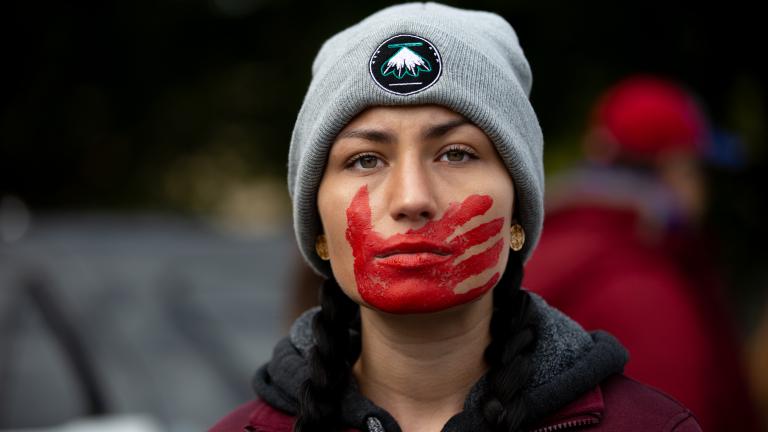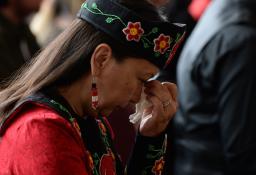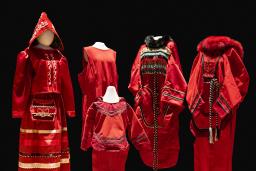Karine Duhamel, who served as the Director of Research for the National Inquiry into Missing and Murdered Indigenous Women and Girls, explains how insights gathered at the inquiry shone a spotlight on human rights and Indigenous rights – and how Canada’s laws must now catch up.
Every Canadian’s responsibility
MMIWG2S+ through the lens of Canadian and international law
By Karine Duhamel
Published: October 4, 2024
Tags:

Credit: Lorie Shaull, CC-BY 2.0
Story text
In June 2019, Canada’s historic National Inquiry into Missing and Murdered Indigenous Women and Girls (NIMMIWG) released its Final Report, Reclaiming Power and Place. Grounded in the testimonies of thousands who came forward – including family members of MMIWG and other experts – the report shares experiences of violence and of the thousands of searches for justice.
As Director of Research for the National Inquiry, I was particularly struck by the way in which family members and survivors of violence were able to connect their experiences to intersecting violations of their human and Indigenous rights – and to Canada’s obligation to address these breaches. It was why, in crafting the Reclaiming Power and Place, we chose an innovative way to directly identify the thousands of rights violations that continue to impact Indigenous women, girls, Two‐Spirit and transgender people today.
Applying a human and Indigenous rights lens, as well as a gendered lens, to the truths shared during the inquiry’s Truth‐Gathering Process reveals how the violence experienced by Indigenous women, girls, Two‐Spirit and transgender people – as well as all forms of violence experienced by Indigenous peoples – is a human rights issue. As family members, loved ones and survivors of violence argued, making the changes required to end this violence is not simply a matter of public policy, but one of domestic and international law. Some of the key factors that allow violence to continue include a failure to uphold basic needs and rights, as Expert Witness Timothy Argetsinger, executive political advisor with Inuit Tapiriit Kanatami (ITK) expressed, “such as housing, [the] right to food, safety, and then the larger issue of violence against women and girls.[1]”
Using an international human rights lens
Brenda Gunn, Métis Professor of Law at the University of Manitoba, argued that using an international human rights‐based approach could help identify which laws have failed to protect Indigenous women, girls and 2SLGBTQQIA people, and which have contributed to the violence in their lives. As she noted in the Final Report, this approach could identify “discriminatory practices and address some of the unjust distributions of power and begin to identify some of Canada’s actions that undercut human rights.”[2] As we saw time and time again in the testimonies, emphasizing how Indigenous women, girls, Two‐Spirit and transgender people are rights holders can help to promote their agency and autonomy – and ultimately, can contribute to reclaiming power and place.
In 2019, Canada was already in violation of its commitments under both international human rights instruments and domestic laws relevant to Indigenous peoples’ rights. Since then, new developments have added to the discussion. Specifically, Canada brought the UN Declaration on the Rights of Indigenous Peoples (UNDRIP) into Canadian law. UNDRIP is important in the context of upholding the individual and collective rights of Indigenous women, girls, Two‐Spirit and transgender people, and in the context of a legislative and a legal system that has, since it was formed, targeted Indigenous women and their descendants directly.
UNDRIP was first adopted by the UN General Assembly in 2007. It affirms both the collective and individual human rights of Indigenous peoples. These rights cover areas such as self‐determination and self‐government, equality rights, rights relating to culture, spirituality and identity, as well as rights relating to lands, territories and resources. Although women are referenced specifically in the Declaration in only one clause, scholars argue that gender is one of its foundational interpretive lenses. While the Declaration has had many critics over the years, there are many Indigenous people, including legal scholars, who have seen it as an instrument with great potential, in part because it grounds the rights of Indigenous peoples in their own customs, laws and traditions.[3]
In 2007, the Government of Canada was one of a handful of countries to vote against UNDRIP, arguing that the Declaration was inconsistent with the Canadian Constitution. However, Indigenous and human rights organizations continued to lobby. In 2010, Canada announced it would officially support the Declaration as an aspirational document, but did not make a firm commitment to change Canadian law. That changed when Canada’s Parliament passed the United Nations Declaration on the Rights of Indigenous Peoples Act (UN Declaration Act), which received royal assent in 2021. This brought UNDRIP into Canadian law and with it, important new commitments.
The Act commits the Government of Canada to working in consultation and cooperation with Indigenous peoples, to taking all measures necessary to ensure the laws of Canada are consistent with UNDRIP, and to preparing and implementing an action plan and reporting on it annually. Framed as an important step in moving Canada’s relationship with Indigenous peoples forward, the Act is intended to affirm UNDRIP as an international human rights instrument that can help interpret and apply Canadian law and to provide a framework to advance implementation of UNDRIP at the federal level. It further formally affirms the role of the legislation in responding to calls from the Truth and Reconciliation Commission (Calls to Action) and from the National Inquiry into Missing and Murdered Indigenous Women and Girls (Calls for Justice).

In its preamble, the Act places emphasis on the role of UNDRIP as a framework for respecting and promoting the inherent rights of Indigenous peoples and a pathway to reconciliation, healing and peace. The preamble also denounces discriminatory doctrines, policies and practices. It affirms the constitutional protection of Aboriginal and treaty rights and emphasizes that all relations between the Government of Canada and Indigenous peoples should be based on Indigenous peoples’ inherent right to self‐determination, including the right of self‐government.
Given its emphasis on a concept called the “consistency of laws,” it’s important to unpack what it is, and what it means in practice. Section 5 on the consistency of laws requires that the Government of Canada adopt measures to ensure laws are consistent with UNDRIP – or in other words, that they respect UNDRIP. This includes taking measures over time to ensure this is the case in consultation and cooperation with Indigenous peoples. Importantly, like the rest of the Act, this obligation applies only to federal laws and does not bind provincial or territorial governments.
We’re constantly being blocked, and challenged, and stopped. And we don’t automatically have the same rights and freedoms as all other Canadians, we just don’t.
Canadian laws: Fighting Against Indigenous Erasure
In Canada, there are many federal laws for which this could have implications. A key battleground for interpretation of the UN Declaration Act will be the Indian Act, established in 1876 through a consolidation of other acts related to “Indians.” Its sex‐based discrimination has been illustrated for nearly 150 years and found to be in violation of international law. In the Indian Act, the definition of an “Indian” is based on the male bloodline, denying the many First Nations people who traced lineage through the mother, or through both bloodlines. In practice, this meant that the status of a First Nations woman depended on the status of her husband – not on her own identity and belonging. By “marrying out,” or marrying a non-“Indian”, she would lose her Indian status and any rights associated with it. Consequences could include being expelled from the community along with her children, who would also be considered not to have status, and losing all her rights to her share of community lands, resources or Treaty provisions.
The Indian Act’s sex‐based bias has also been used in other ways, most notably in the enforcement of early prostitution clauses within the Act, which criminalized First Nations women and girls, despite no concrete evidence of more frequent engagement in the sex trade than other women. These actions were further exacerbated by related amendments to the Criminal Code in 1892.[4] Further, until 2008, complaints to the Canadian Human Rights Tribunal against the federal government about decisions or actions arising from or pursuant to the Indian Act were not allowed under section 67, with important impacts for families. As family member Wendy L. shared: “It’s just these constant obstacles that are put in our place […] We’re constantly being blocked, and challenged, and stopped. And we don’t automatically have the same rights and freedoms as all other Canadians, we just don’t.”[5]
Amendments have been made to address overt discrimination within the Act in terms of its provisions for who may be considered an “Indian.” However, many issues remain, including the different kinds of “Indian Status” and the different rules around how that status can be passed on. For instance, as a 6(1) Status person, I can enroll my biological children for status. However, they are considered 6(2) Status people, so their children will not be eligible for status under the current rules. My family will effectively cease to have access to Treaty rights unless the Act is changed or abolished. It is, in essence, genocide by paper.
As Elder Miigam’agan pointed out in the Final Report, “When we deny a woman and her children through the Indian Act legislation, you are banishing […] our family members. When you look at that in our language and in our understanding, that banishment is equivalent to capital punishment … when you banish a person they cease to exist.”[6]

As these testimonies pointed out, the Indian Act’s provisions regarding status stand in direct opposition to UNDRIP’s Article 33, which highlights the principle that Indigenous peoples have the right to determine their own identity or membership, structure and processes in accordance with their customs and traditions, and Article 22, which specifically sets out the obligation of both states and Indigenous nations “to ensure that indigenous women and children enjoy the full protection and guarantees against all forms of violence and discrimination.” Finally, Article 9 further provides that “Indigenous peoples and individuals have the right to belong to an indigenous community or nation, in accordance with the traditions and customs of the community or nation concerned. No discrimination of any kind may arise from the exercise of such a right.”
In terms of the consistency of laws, then, many groups, including the Assembly of First Nations, have called on the Government of Canada “to end the practice of legislative assimilation and to provide adequate funding to First Nation governments to establish their own citizenship laws and processes” and to “support the work of all First Nations who now exercise their jurisdiction over their citizenship and restore their children with their rightful heritage.” This is in accordance with the government’s obligations under the consistency of laws in the UN Declaration Act, with the requirement to do so in cooperation with Indigenous peoples.
From the perspective of the thousands of family members and survivors who spoke out on the issue of violence against Indigenous women, girls, Two‐Spirit and transgender people, these are uncertain times. Enthusiasm for the potential of the UN Declaration Act, three years after its adoption, seems to have been tempered by slow progress. While many have expressed hope in terms of what the UN Declaration Act can do to address the laws that have served to discriminate against Indigenous women, like the Indian Act and others, many also remain wary of how the Act may be interpreted by the courts and by decision‐makers.

Indigenous women, girls, Two‐Spirit and transgender people are rights holders, and the UN Declaration Act, alongside other instruments, should prompt Canada to take significant and decisive action. Its own commitments demand this.
As people in Canada, we, too, must act. As National Inquiry Grandmother, family member and survivor Bernie Williams shared, “If you’re not outraged, you’re not paying attention. This is every Canadian’s responsibility not to turn a blind eye.”
Emphasizing how Indigenous women, girls, Two-Spirit and transgender people are rights holders can help to promote their agency and autonomy – and ultimately, can contribute to reclaiming power and place.
Ask yourself:
What can be learned by how Indigenous peoples advocate for their legal and human rights?
What concerns do Indigenous peoples in Canada have about the Indian Act?
What other ways, besides changing laws, can we all help to protect human rights?
Explore further
The United Nations Declaration on the Rights of Indigenous Peoples
By Karine Duhamel
What is the UNDRIP and why is it important? What does Canada’s commitment to enact UNDRIP mean? How will it impact treaty rights, land, resources and cultural rights in Canada?

Missing and Murdered Indigenous Women, Girls and 2SLGBTQI+ People
In this guide, you will find links to resources related to the epidemic of missing and murdered Indigenous women, girls and 2SLGBTQI+ people in Canada and the United States.

References
- Final report of the NIMMIWG, Volume 1a, p. 181. Back to citation 1
- Final report of the NIMMIWG, Volume 1a, p. 182. Back to citation 2
- Final report of the NIMMIWG, Volume 1a, p. 194. Back to citation 3
- Final report of the NIMMIWG, Volume 1a, p. 254. Back to citation 4
- Final report of the NIMMIWG, Volume 1a, p. 208. Back to citation 5
- Final report of the NIMMIWG, Volume 1a, p. 251. Back to citation 6
Suggested citation
Suggested citation : Karine Duhamel. “Every Canadian’s responsibility.” Canadian Museum for Human Rights. Published October 4, 2024. https://humanrights.ca/story/every-canadians-responsibility